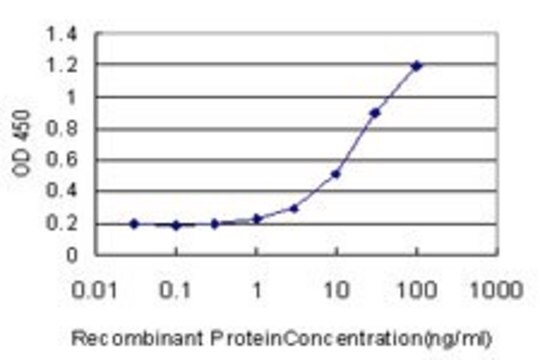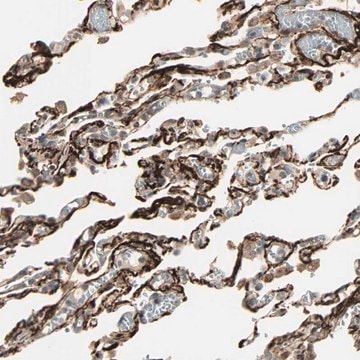推荐产品
生物源
mouse
品質等級
抗體表格
purified immunoglobulin
抗體產品種類
primary antibodies
無性繁殖
4F8.1, monoclonal
物種活性
human
包裝
antibody small pack of 25 μg
技術
immunohistochemistry: suitable (paraffin)
western blot: suitable
同型
IgG2bκ
NCBI登錄號
UniProt登錄號
目標翻譯後修改
unmodified
基因資訊
human ... RAMP1(10267)
一般說明
Receptor activity-modifying protein 1 (UniProt: O60894; also known as Calcitonin-receptor-like receptor activity-modifying protein 1, CRLR activity-modifying protein 1, RAMP1) is encoded by the RAMP1 gene (Gene ID: 10267) in human. RAMP1 is a single-pass type I membrane protein that is involved in the transports of calcitonin gene-related peptide type 1 receptor (CALCRL) to the plasma membrane and acts as a receptor for calcitonin-gene-related peptide (CGRP) together with CALCRL. RAMP1 lacks glycosylation sites and does not migrate to the cell surface independently. To reach the cell surface, it aggregates inside the cytoplasm and forms heterodimers with calcitonin. It is expressed in many tissues including the uterus, bladder, brain, pancreas, retina, and gastro-intestinal tract. It is synthesized with a signal peptide (aa 1-26), which is cleaved to generate the mature form. Mature RAMP1 has an extracellular domain (aa 27-117); a transmembrane domain (aa 118-138); and a short cytoplasmic tail (aa 139-148). RAMP1 is reported to acts as a vasodilation factor and mice deficient in RAMP1 exhibit inflammatory responses with a transient, but significant, increase in serum calcitonin-gene-related peptide levels and pro-inflammatory cytokines. (Ref.: Nakayama, T., et al. (2017). J. Hum. Hypertens. 31(5); 361-365).
特異性
Clone 4F8.1 specifically detects Receptor activity-modifying protein 1 (RAMP1) in human cells. It targets an epitope within 91 amino acids from the internal region.
免疫原
GST/His-tagged recombinant fragment corresponding to 91 amino acids from the internal region of human Receptor activity-modifying protein 1 (RAMP1).
應用
Anti-RAMP1, clone 4F8.1, Cat. No. MABS1904, is a mouse monoclonal antibody that detects Receptor activity-modifying protein 1 (RAMP1) and has been tested for use in Immunohistochemistry (Paraffin) and Western Blotting.
Immunohistochemistry Analysis: A 1:250 dilution from a representative lot detected RAMP1 in human uterus and human colon tissue sections.
Research Category
Signaling
Signaling
品質
Evaluated by Western Blotting in human brain tissue lysate.
Western Blotting Analysis: 0.5 µg/mL of this antibody detected RAMP1 in human brain tissue lysate.
Western Blotting Analysis: 0.5 µg/mL of this antibody detected RAMP1 in human brain tissue lysate.
標靶描述
~17 kDa observed; 16.99 kDa calculated. Uncharacterized bands may be observed in some lysate(s).
外觀
Protein G purified
Format: Purified
Purified mouse monoclonal antibody IgG2b in buffer containing 0.1 M Tris-Glycine (pH 7.4), 150 mM NaCl with 0.05% sodium azide.
儲存和穩定性
Stable for 1 year at 2-8°C from date of receipt.
其他說明
Concentration: Please refer to lot specific datasheet.
免責聲明
Unless otherwise stated in our catalog or other company documentation accompanying the product(s), our products are intended for research use only and are not to be used for any other purpose, which includes but is not limited to, unauthorized commercial uses, in vitro diagnostic uses, ex vivo or in vivo therapeutic uses or any type of consumption or application to humans or animals.
Not finding the right product?
Try our 产品选型工具.
儲存類別代碼
12 - Non Combustible Liquids
水污染物質分類(WGK)
WGK 1
閃點(°F)
Not applicable
閃點(°C)
Not applicable
Camille Cohen et al.
Nature communications, 15(1), 743-743 (2024-01-26)
Chronic kidney disease (CKD) is a public health problem driven by myofibroblast accumulation, leading to interstitial fibrosis. Heterogeneity is a recently recognized characteristic in kidney fibroblasts in CKD, but the role of different populations is still unclear. Here, we characterize
我们的科学家团队拥有各种研究领域经验,包括生命科学、材料科学、化学合成、色谱、分析及许多其他领域.
联系技术服务部门








